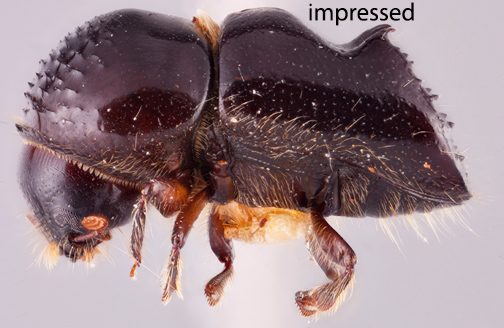Cyclorhipidion bispinum
Taxonomic history
Xyleborus bispinus Nobuchi, 1981a: 147.
Cyclorhipidion bispinum (Nobuchi): Smith et al. 2018b: 394.
Synonyms
Xyleborus kumanoensis Nobuchi, 1985: 25 (unnecessary new name for X. bispinus nec Schedl, 1979).
Diagnosis
1.9−2.1 mm long; 2.6 times as long as wide (Nobuchi 1981aNobuchi 1981a:
Nobuchi A. 1981a. Studies on Scolytidae (Coleoptera) XXII. Six new species and two new females of the genus Xyleborus from Japan. Kontyucirc; 49: 143-154.). This species is distinguished by the elytralelytral:
pertaining to the elytra
discdisc:
the flat central upper surface of any body part (e.g. pronotum and elytra) with a median shallow saddle-like impression; declivitaldeclivital:
with a median shallow saddle-like impression; declivitaldeclivital:
pertaining to the elytral declivity
interstriae 2 unarmed; declivitydeclivity:
downward slope of either the pronotum or elytra
 very steep, posterolateralposterolateral:
very steep, posterolateralposterolateral:
relating to end of the side part/portion
 margin costate; elytralelytral:
margin costate; elytralelytral:
pertaining to the elytra
apexapex:
point or edge furthest from the body; opposite of base
 bearing two denticlesdenticle:
bearing two denticlesdenticle:
a small tooth, the sides of which are equal and the tip is above the middle of the base , one on each interstriaeinterstria:
, one on each interstriaeinterstria:
longitudinal spaces along the elytra between the striae, which is not as<br />
impressed and bear smaller punctures.
 2; and striaestria:
2; and striaestria:
punctures in rows, which may or may not be impressed to make grooves slightly impressedimpressed:
slightly impressedimpressed:
a depression in a surface
 .
.
May be confused with
Cyclorhipidion armiger, C. laciniosum, C. miyazakiense, C. obesulum, and C. xyloteroides
Distribution
Japan
Host plants
recorded from Castanopsis cuspidata (Fagaceae) (Nobuchi 1981aNobuchi 1981a:
Nobuchi A. 1981a. Studies on Scolytidae (Coleoptera) XXII. Six new species and two new females of the genus Xyleborus from Japan. Kontyucirc; 49: 143-154.)
Remarks
A specimen of this species was unable to be examined as part of this study. Images of the holotype are available from the NIAES website
DNA data
specimens not available for sequencing

